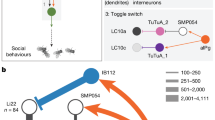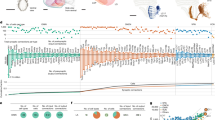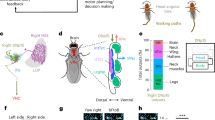Abstract
The small insect brain is often described as an input/output system that executes reflex-like behaviours. It can also initiate neural activity and behaviours intrinsically, seen as spontaneous behaviours, different arousal states and sleep. However, little is known about how intrinsic activity in neural circuits affects sensory information processing in the insect brain and variability in behaviour. Here, by simultaneously monitoring Drosophila’s behavioural choices and brain activity in a flight simulator system, we identify intrinsic activity that is associated with the act of selecting between visual stimuli. We recorded neural output (multi-unit action potentials and local field potentials) in the left and right optic lobes of a tethered flying Drosophila, while its attempts to follow visual motion (yaw torque) were measured by a torque meter. We show that when facing competing motion stimuli on its left and right, Drosophila generate large torque responses that flip from side to side. The delayed onset (0.1-1 s) and spontaneous switch-like dynamics of these responses make this behaviour different from the classic steering reflexes. Drosophila, thus, seem to choose one stimulus at a time and attempt to rotate toward its direction. With this behaviour, the neural output of the optic lobes alternates; being augmented on the side chosen for body rotation and suppressed on the opposite side, even though the visual input to the fly eyes stays the same. Thus, the flow of information from the fly eyes seems gated intrinsically, with this process highlighting chosen information while ignoring the irrelevant. We propose that in small insect brains of limited capacity, intrinsic activity can play an important role in modulating neural information processing and behaviour.
Similar content being viewed by others
Article PDF
Author information
Authors and Affiliations
Corresponding authors
Rights and permissions
About this article
Cite this article
Tang, S., Juusola, M. Intrinsic Activity in the Fly Brain Gates Visual Information during Behavioral Choices. Nat Prec (2010). https://doi.org/10.1038/npre.2010.4325.1
Received:
Accepted:
Published:
DOI: https://doi.org/10.1038/npre.2010.4325.1
Keywords
This article is cited by
-
Behavioural and neural responses of crabs show evidence for selective attention in predator avoidance
Scientific Reports (2022)



